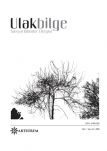YORUMLANAN CAMİ MİMARİSİ
INTERPRETING THE MOSQUE ARCHITECTURE
Author(s): Meltem ÖzçakıSubject(s): Cultural history, Architecture, Islam studies, Sociology of Art, Sociology of Religion
Published by: Sanat ve Dil Araştırmaları Enstitüsü
Keywords: Mosque; Architecture; Modern; Contemporary; Dome; Minaret; Technology;
Summary/Abstract: Mosques are evaluated as buildings that are expected to have a characteristic form today. The reasons of this are religious rituals do not change over time; there is not a demand to change the mosque architecture and continuity in structure, perception, aesthetic taste of the community. However, mosque architecture has experienced alterations since the first mosque buildings. Differences arise because of different geographies, climate, cultural structure, local characteristics, traditional materials, and the present building culture. Today in our country, mosques have been built which especially feature the characteristics of the 16th century Ottoman mosque architecture. Also, there are mosques which can be seen as modern though little in quantity.The study aims to examine what are the belonging properties of traditional mosques such as form, earned identity, meaning and sense; how these were transformed through history and how do they evaluated in the modern mosques. The study focuses on the contemporary mosque concept. It examines the properties of modern mosques. The issue is studied through examples. Characteristics that define modern mosques are evaluated along with how they were practiced in traditional mosques. These buildings are examined through the connection to their immediate surroundings, top cover systems, use of the dome, stylistic characteristic of the minarets, simple or complex designs, ornamental elements on the outer and interior spaces, and use of contemporary building technologies and materials.
Journal: Ulakbilge Sosyal Bilimler Dergisi
- Issue Year: 6/2018
- Issue No: 23
- Page Range: 459-483
- Page Count: 25
- Language: Turkish

